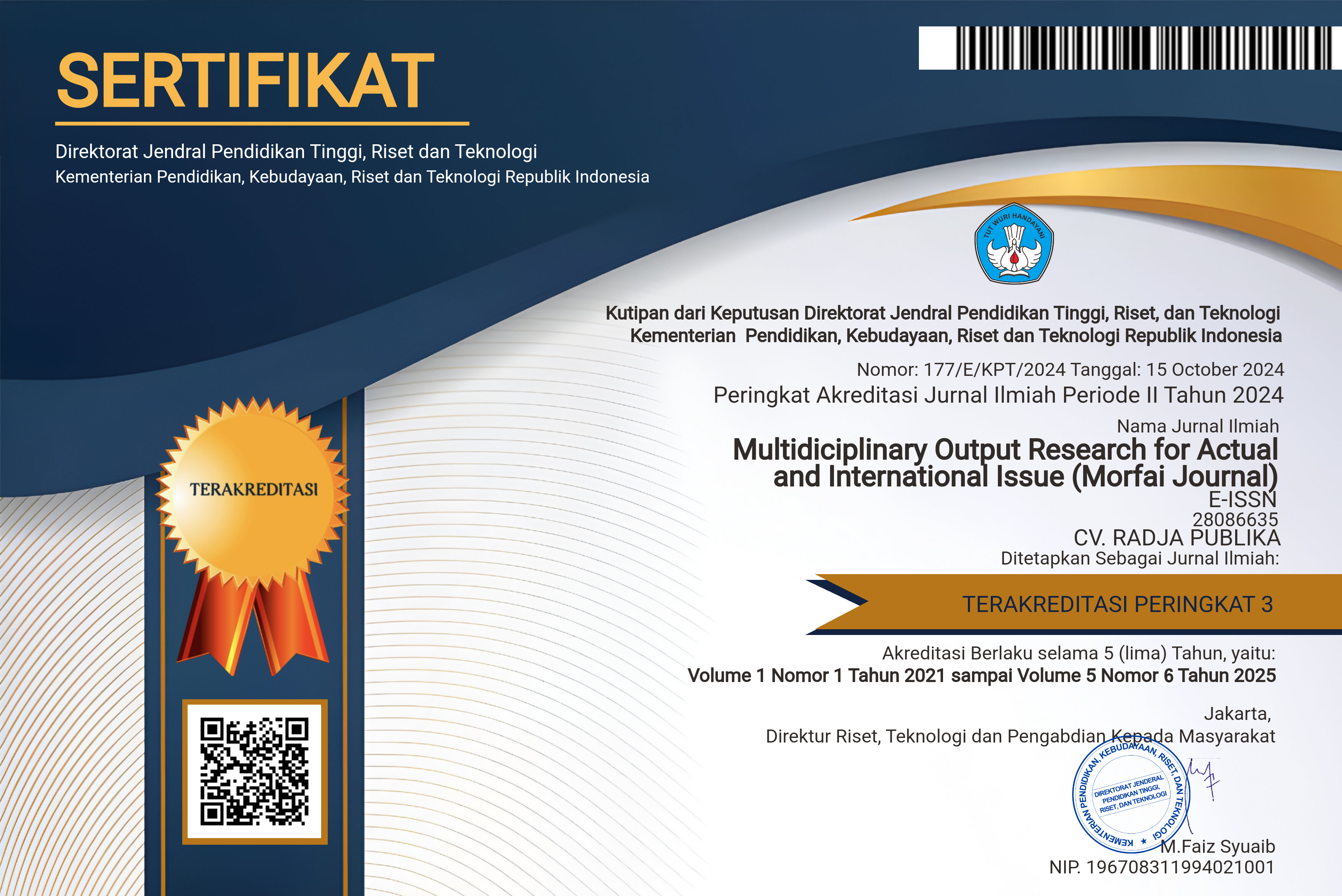INTRINSIC VS. EXTRINSIC MOTIVATION: WHICH DRIVES HIGHER PERFORMANCE IN HIGH-PRESSURE JOBS?
Main Article Content
Rian Irvandi
Oktavianti
Rizki Eka Putra
This study investigates the impact of intrinsic versus extrinsic motivation on performance and well-being in high-pressure professions. Against a backdrop of high burnout rates in fields like medicine and finance, the literature reveals a complex interplay: intrinsic motivation is linked to resilience and creativity, while extrinsic rewards can undermine intrinsic drive via the overjustification effect. Using a mixed-methods approach, this research combined quantitative surveys with qualitative interviews. Results demonstrated a strong positive correlation between intrinsic motivation and both high performance ratings and low burnout. Extrinsic motivation showed a more complex, curvilinear relationship. The discussion proposes a "Motivational Hierarchy" where intrinsic factors form the essential foundation, and extrinsic rewards are most effective as supporting enablers. The conclusion urges organizations to cultivate autonomy, mastery, and purpose to foster sustainable high performance.
Chong, J. X. Y., & Gagné, M. (2019). Self-Determination Theory for Work Motivation. In Management. Oxford University Press. https://doi.org/10.1093/obo/9780199846740-0182
Cromwell, J. R., Haase, J., & Vladova, G. (2023). The creative thinking profile: Predicting intrinsic motivation based on preferences for different creative thinking styles. Personality and Individual Differences, 208, 112205. https://doi.org/10.1016/j.paid.2023.112205
Deci, E. L., Olafsen, A. H., & Ryan, R. M. (2017). Self-Determination Theory in Work Organizations: The State of a Science. Annual Review of Organizational Psychology and Organizational Behavior, 4(1), 19–43. https://doi.org/10.1146/annurev-orgpsych-032516-113108
Di Domenico, S. I., & Ryan, R. M. (2017). The Emerging Neuroscience of Intrinsic Motivation: A New Frontier in Self-Determination Research. Frontiers in Human Neuroscience, 11. https://doi.org/10.3389/fnhum.2017.00145
Edmondson, S., Wright, K., Jackson, B., Simpson, A., & Furzer, B. (2025). Thriving Under Threat: A Scoping Review of Human Thriving in Recurring Potentially Traumatic, Elevated Threat and High Stress Work Environments. Stress and Health, 41(4). https://doi.org/10.1002/smi.70084
Gunasekare, U. L. T. P. (2016). Self Determination Theory (SDT): a review on SDT as a Complementary Theory of Motivation. Kelaniya Journal of Human Resource Management, 11(1), 58. https://doi.org/10.4038/kjhrm.v11i1.28
Guo, M. (2023). Motivation at work: An analysis from the self-determination theory perspective. SHS Web of Conferences, 180, 03017. https://doi.org/10.1051/shsconf/202318003017
Hennessey, B., Moran, S., Altringer, B., & Amabile, T. M. (2015). Extrinsic and Intrinsic Motivation. In Wiley Encyclopedia of Management (pp. 1–4). Wiley. https://doi.org/10.1002/9781118785317.weom110098
Jacobs, E., & Keegan, R. J. (2022). Sustaining optimal performance when the stakes could not be higher: Emotional awareness and resilience in emergency service personnel (with learnings for elite sport). Frontiers in Psychology, 13. https://doi.org/10.3389/fpsyg.2022.891585
Jolliff, A., & Strubler, D. (2021). Integrating Model of Resilience, Engagement, and Motivation. International Journal of Business and Management Research, 9(2), 178–189. https://doi.org/10.37391/IJBMR.090208
K, J., & Ranjit, G. (2022). Explicating intrinsic motivation’s impact on job performance: employee creativity as a mediator. Journal of Strategy and Management, 15(4), 647–664. https://doi.org/10.1108/JSMA-04-2021-0091
Khazei, M., Shukor, A. R., & Biotech, M. (2020). A Novel Instrument for Integrated Measurement and Assessment of Intrinsic Motivation, Team Climate, and Burnout in Multidisciplinary Teams. The Permanente Journal, 24(2). https://doi.org/10.7812/TPP/19.155
Kuvaas, B. (2018). Chapter 12: The Relative Efficiency of Extrinsic and Intrinsic Motivation. In At the Forefront, Looking Ahead (pp. 198–213). Universitetsforlaget. https://doi.org/10.18261/9788215031583-2018-13
Luria, E. (2022). Revisiting the Self-Determination Theory-Motivating the Unmotivated. Educational Practice and Theory, 44(2), 5–14. https://doi.org/10.7459/ept/44.2.02
Manganelli, L., Thibault-Landry, A., Forest, J., & Carpentier, J. (2018). Self-Determination Theory Can Help You Generate Performance and Well-Being in the Workplace: A Review of the Literature. Advances in Developing Human Resources, 20(2), 227–240. https://doi.org/10.1177/1523422318757210
MATEI, M., ABRUDAN, M.-M., SĂVEANU, T.-G., & SCÎNTEE, A. A. (2025). INTRINSIC AND EXTRINSIC MOTIVATION IN ACADEMIA: A MIXED-METHOD EXPLORATION OF MOTIVATIONAL DRIVERS. The Annals of the University of Oradea Economic Sciences, 551. https://doi.org/10.47535/1991AUOES34(1)046
Norton, J. (2018). The Science of Motivation Applied to Clinician Burnout: Lessons for Healthcare. Frontiers of Health Services Management, 35(2), 3–13. https://doi.org/10.1097/HAP.0000000000000049
Rantung, G., Griffiths, D., Plummer, V., & Moss, C. (2022). How emergency nurses cope and motivate themselves to sustain their caring work: An integrative literature review. Journal of Clinical Nursing, 31(7–8), 843–859. https://doi.org/10.1111/jocn.16005
Rigby, C. S., & Ryan, R. M. (2018). Self-Determination Theory in Human Resource Development: New Directions and Practical Considerations. Advances in Developing Human Resources, 20(2), 133–147. https://doi.org/10.1177/1523422318756954
Sahabuddin, S., Jumady, E., & Fajriah, Y. (2025). Qualitative Study on the Effect of Workload and Motivation on Performance with Supervision and SOP as Mediator Variables. Golden Ratio of Human Resource Management, 5(1), 241–250. https://doi.org/10.52970/grhrm.v5i1.863
Steele, L. M., McIntosh, T., & Higgs, C. (2017). Intrinsic motivation and creativity: Opening up a black box. In Handbook of Research on Leadership and Creativity. Edward Elgar Publishing. https://doi.org/10.4337/9781784715465.00013
Szalma, J. L. (2017). Stress and Performance in Emergency Medical Services. In Human Factors and Ergonomics of Prehospital Emergency Care (pp. 53–70). CRC Press. https://doi.org/10.1201/9781315280172-5
Turner, A. (2017). How does intrinsic and extrinsic motivation drive performance culture in organizations? Cogent Education, 4(1), 1337543. https://doi.org/10.1080/2331186X.2017.1337543
Van den Broeck, A., Howard, J. L., Van Vaerenbergh, Y., Leroy, H., & Gagné, M. (2021). Beyond intrinsic and extrinsic motivation: A meta-analysis on self-determination theory’s multidimensional conceptualization of work motivation. Organizational Psychology Review, 11(3), 240–273. https://doi.org/10.1177/20413866211006173
Wild, J., El-Salahi, S., & Esposti, M. D. (2020). The Effectiveness of Interventions Aimed at Improving Well-Being and Resilience to Stress in First Responders. European Psychologist, 25(4), 252–271. https://doi.org/10.1027/1016-9040/a000402









